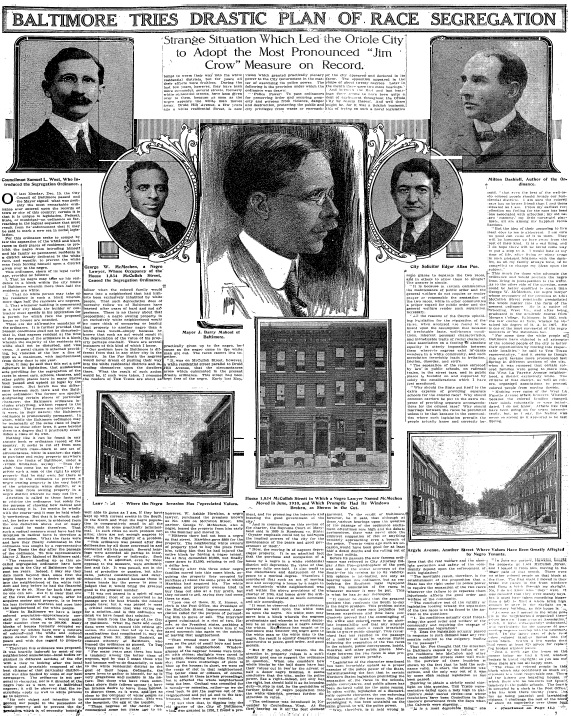
Well, this might be the most depressing and disgusting thing I’ve come across so far in these old articles. The city of Baltimore passed an ordinance that says:
1. That no negro may take up his residence in a block within the city limits of Baltimore wherein more than half the residents are white.
2. That no white person may take up his residence in such a block wherein more than half the residents are negroes.
3. That whenever building is commenced in a new city block the builder or contractor must specify in his application for a permit for which race the proposed house or houses are intended.
It’s terrible. But what did the locals think? The Times contacted a woman in Baltimore society for her opinion. “It is a most deplorable thing,” she said, and I felt a bit of relief, until I read the rest of the sentence:
“It is a most deplorable thing,” she said, “that even the best of the well-to-do colored people should invade our residential districts. I am sure the colored race has no better friend than I and those situated as I am. From my earliest recollection my feeling for the race has been one associated with affection; my old negro ‘mammy,’ my little nurse-girl playmate, all are among my happiest recollections.
But the idea of their assuming to live next door to me is abhorrent. I am sure no good can come of it to them. They will be lonesome up here away from the rest of their kind. It is a sad thing, and I do hope there will be found some way to put a stop to it. I would hate at my time of life, after living so many years in such pleasant relations with the darkies, as all my family always have, to be compelled to change my ideas upon the subject.”
Yikes. For an opposing viewpoint, the Times found a black man with some expertise on the matter. For one thing, it was his own occupancy of a home in Baltimore that practically precipitated the whole ordeal. And for another, he happens to be one of the most successful black lawyers in Baltimore. Let’s see what he has to say:
“The class of colored people in this block which has occasioned so much excitement is a most respectable one. Three of the houses are boarding houses, in which there are no boarders but female teachers in the public schools. The fourth is occupied by a clerk in the Post Office, who has been there twenty years. As far as being peaceful and lawabiding citizens, I challenge the rest of the block to show its superiority over those four colored families. We did not move up there because we wished to force our way among the whites; association with them in a social way would be just as distasteful to us as it would be to them. We merely desired to live in more commodious and comfortable quarters. There were many vacant houses in the block when I moved in; these the colored families I have mentioned have taken.
“As for property deteriorating on account of our advent in that neighborhood, I know it cannot be so, because all of us are paying higher rentals than the white occupants who immediately preceded us, and there is no better criterion of value than the rent a property brings. I have lived now for several months with white people next door to me on either hand, and we have never had the slightest difficulty. I do not try to associate with them socially any more than they with me, and I am sure none of us have any such desire, nor will any attempt be made on my part…
“As to the ordinance in question, it is my opinion as a lawyer that it is clearly unconstitutional, unjust, and discriminating against the negro, although on its face it appears to be equally fair to white and black.”
I can feel the tension in 1910 Baltimore just reading about it.
The Supreme Court ruled racial zoning unconstitutional in 1917. So Baltimore instead turned to the use of racial covenants to keep white neighborhoods white. By the 1930s, African Americans made up 20% of Baltimore’s population, but were confined to 2% of the city’s land area.
It wasn’t until 1968, days after Martin Luther King, Jr. was assassinated, that Baltimore passed a Fair Housing Act to end racial discrimination in housing.
BALTIMORE TRIES DRASTIC PLAN OF RACE SEGREGATION: Strange Situation Which Led the Oriole City to Adopt the Most Pronounced “Jim Crow” Measure On Record (PDF)
From December 25, 1910
Leave a comment